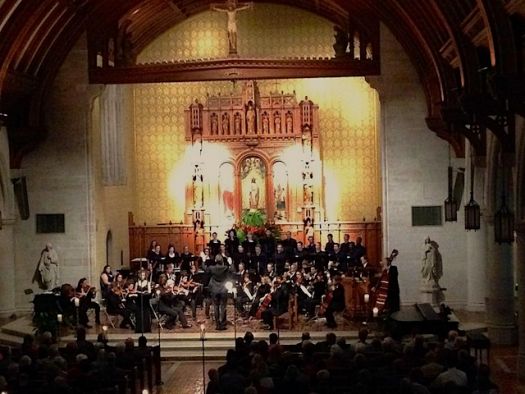
Mozart, Pärt Mark Annual VAE, CCO Collaboration

The most sublime moment during Sunday afternoon’s concert by the Cincinnati Chamber Orchestra and the Vocal Arts Ensemble at St. Catharine of Siena Church in Westwood came at the very end.
Conductor/CCO music director Mischa Santora paused a long moment before dropping his hands at the conclusion of Arvo Pärt’s “Te Deum.” The rain had stopped. No one moved. Miraculously, there was not a sound in the church, not even a stray cough, as the effect of the music sank in.
The concert marked the annual collaboration by the CCO and the VAE (directed by Craig Hella Johnson). A near capacity crowd attended, itself remarkable in view of the storms and high winds passing through the tristate during the afternoon and early evening.
Sharing the program with Pärt’s “Te Deum” was Mozart’s Mass in C Minor, K. 427 (“Great”), a work which in one form or another enjoyed a full weekend in Cincinnati. (Just the night before, at Music Hall downtown, the Cincinnati Symphony Orchestra and May Festival Chorus led by the CSO’s new music director Louis Langrée, performed Mozart’s cantata “Davide penitente,” which Mozart derived from movements of his C Minor Mass.)
Soloists in the Mass, all members of the VAE, were sopranos Melissa Harvey and Erin Keesy, tenor Anthony Beck and bass Claude Cassion.
The acoustics in St. Catharine’s gracious, barrel-vaulted interior are superior, with just enough reverberation to be warm and welcoming, but still allow lines to be distinctly heard. For the 25-voice VAE it was a perfect environment, and balances with the CCO and soloists were excellent.
The opening “Kyrie” brought soprano Harvey to the front for a sweetly enunciated “Christe eleison.” The “Gloria in excelsis Deo,” which followed, raised a quick joyous shout. Soprano Keesy was soloist in “Laudamus te,” an exacting coloratura vehicle which showed off her substantial voice. She and Harvey joined in “Domine Deus,” where the comparative weight of their voices was sometimes evident, however. The chorus “Qui tollis peccata mundi,” a highpoint of the Mass, showed the VAE clear, translucent and in strict adherence to its sudden dynamic changes.
Tenor Beck joined the two sopranos in “Quoniam tu solus Sanctus,” making for a lovely ensemble, coloratura and all, while the “Credo,” with its infectious leaping figures in the CCO, raised another joyful noise in the church. The CCO winds set the tone for “Et incarnatus est” with soprano Harvey, engaging in lovely interaction throughout, including the engaging cadenza at the end.
After the “Sanctus,” a spine-tingler with its brassy interjections, and grand, polyphonic “Hosanna in excelsis,” the full quartet of soloists, including bass Cassion, joined the VAE and CCO in the “Benedictus,” which ended the Mass on a bright, exultant note.
Estonian composer Arvo Pärt’s “Te Deum” (1984) is set for three choirs, string orchestra, prepared piano (a piano with objects inserted in it to alter the sound, here metal screws behind the dampers on four selected pitches) and pre-recorded wind harp. The composer wrote it, he said, to extract a slice of time from infinity “by delicately removing one piece . . . out of silence and emptiness.” In it, he utilizes his “tintinnabuli” style, i.e. a minimalist compositional style in which the music is structured around a central triad and a set of scalar pitches. The VAE built the three choirs from its members.
The lights went down in the church for the work, leaving it partially lit by candlelight. It began with wind harp. Responsible for the instrument was CCO assistant conductor Isaac Selya who manned a pair of laptops, each with a CD for one of the two wind harp pitches, which acted as drones.
The 30-minute work unfolded in three parts, with chant-like portions for the choirs and interludes by the CCO strings. It was indeed an otherworldly experience, with contrasting textures and colors, extremes of dynamics (louds and softs) and the wind harp heard more or less prominently throughout.
There was only one glitch -- not the fault of the performers, but the time of day. Promptly at 6 p.m. about two-thirds through the ”Te Deum,” a church bell starting ringing, which in view of the nature of Pärt’s music, seemed not that discordant.